To celebrate chess in all its myriad facets, the Global Chess Festival is here once more
From building character to sharpening cognitive abilities to meliorating neurological disorders like Autism, the benefits of the ancient game of chess are many and wide-ranging. In fact, having evolved through one and a half millennia, it is more than just a game today. It is a cultural and intellectual phenomenon: an inspiration for visual artists, a playground for experimentation for scientists, and a pedagogical tool for educationists—but more than anything else, it is a common tongue connecting people across gender, ethnicity and generation. Judit Polgar's Global Chess Festival is an event that is held every year in Budapest, Hungary, to celebrate this very diversity of chess. It is a gala that invites not only players but professionals from various other disciplines with the sole aim of promoting chess in all its myriad facets. This year the singular event is taking place on the 8th of October. We walk you through its different planned activities and present four original studies for solving that are part of its special program, Chess Artistry Adventure, in memory of the late Pal Benko.

Judit Polgar, the unanimously crowned queen of chess, the strongest female chess player of all time, may not be active in competitions anymore but her incessant efforts to popularize the game of chess in ever new ways has kept her charisma and presence intact in the chess world. The Global Chess Festival, her prized brainchild, represents everything she has come to stand for over the years. The mission of this event, to quote from its website itself, is to promote "the 1000 faces of chess all around the world." Judit has always been a jubilant advocate of chess as a means to unite people across boundaries, in her own words: "In chess the most unbelievable thing ... is that it's a game for everybody: rich, poor, girl, boy, old, young. It's a fantastic game which can unite people and generations! It's a language which you'll find people "speak" in every country. If you reach a certain level you find a very rich world!" Thus, chess for all, echoing FIDE's motto Gens Una Sumus (French for "We are one people"), is the key theme of this grand event that runs through all its programs.
Speaking of unity, talks about integrating chess into educational curriculums have been around for quite some time now, chess being so universal in nature is also an ideal tool to promote holistic development in children. How can this be done? What are the advantages of a chess-oriented education starting early in pre-school? A world-class "Educational Chess Summit" has been dedicated in the event just for the discussion of these vital questions. This summit isn't new and was also a part of the previous edition of the Global Chess Festival, and it's goal is to showcase the best and the most innovative educational programs and their results.
A Holistic Idea of Education with Chess as its Centerpiece.
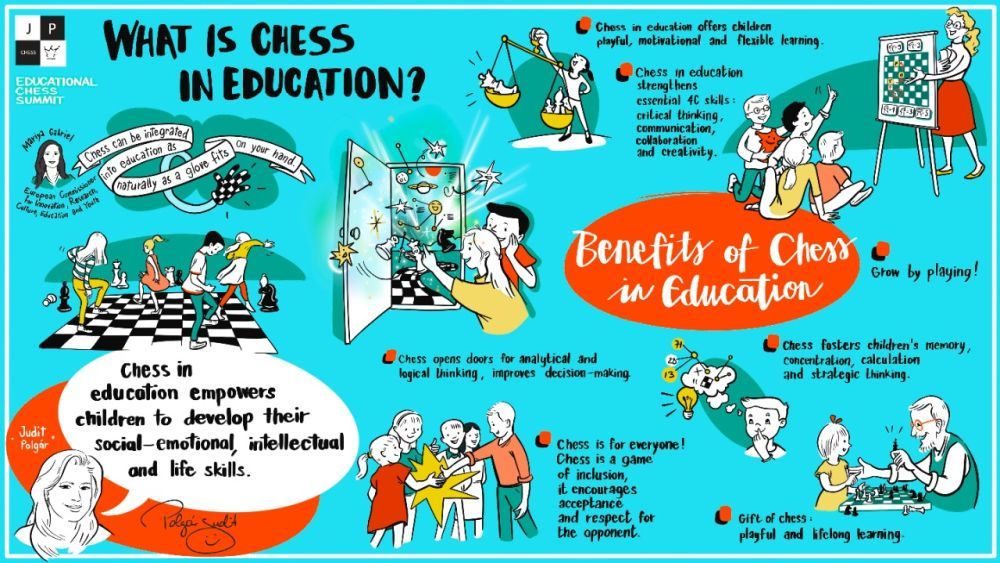
Chess, it is said, is a game that's easy to learn but extremely hard to master. This is precisely why it can be so effective a pedagogical tool. Chess can be (and frequently is) difficult for even the most seasoned Grandmasters, but its basic rules are surprisingly simple—simple enough for any 6-year-old to begin playing it. Just an eight by eight checkered board and a few types of pieces and you have a whole new world of endless creativity and problem-solving, is there a better paradigm for kids to hone their cognitive and analytical skills?
But chess is not just about sharpening the intellect. As any chess player would tell you, the process of learning the game itself is highly enriching and endows one with qualities for life. Like any sport, it teaches the ability to tackle pressure situations, live in the present moment and handle losses with grace. In short: it builds character. Moreover, chess players who travel around the world develop a multicultural outlook. One makes friends across the globe—once again, inclusion and unity!
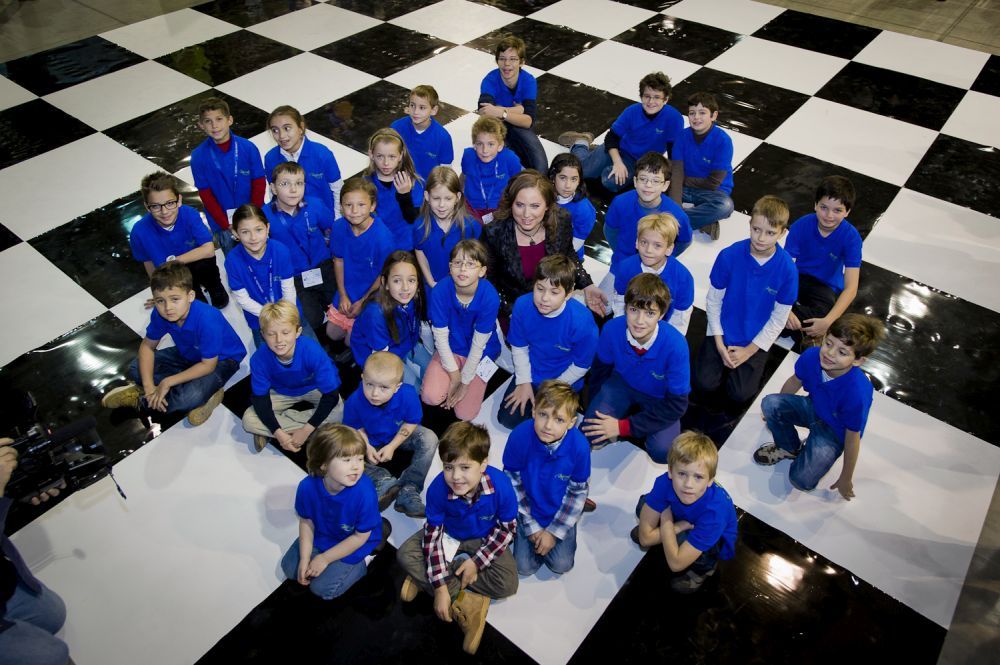
The welcome speech of the Education Summit this year would be delivered by Dr. Mikheil Chkhenkeli, the Minister of Education and Science of Georgia. Dr. Chkhenkeli is also the patron of this summit. Besides him, many acknowledged educationists, chess players, innovators and thinkers will be delivering speeches. Judit's father, László Polgár, an educational psychologist, is best-known in the chess world for the unorthodox way he raised the three Polgar sisters into becoming chess prodigies. In this regard, it can be said that Judit is following in her father's footsteps by finding ways to make learning for kids more innovative and fun.
Now let's introduce some of the distinguished speakers in the summit:


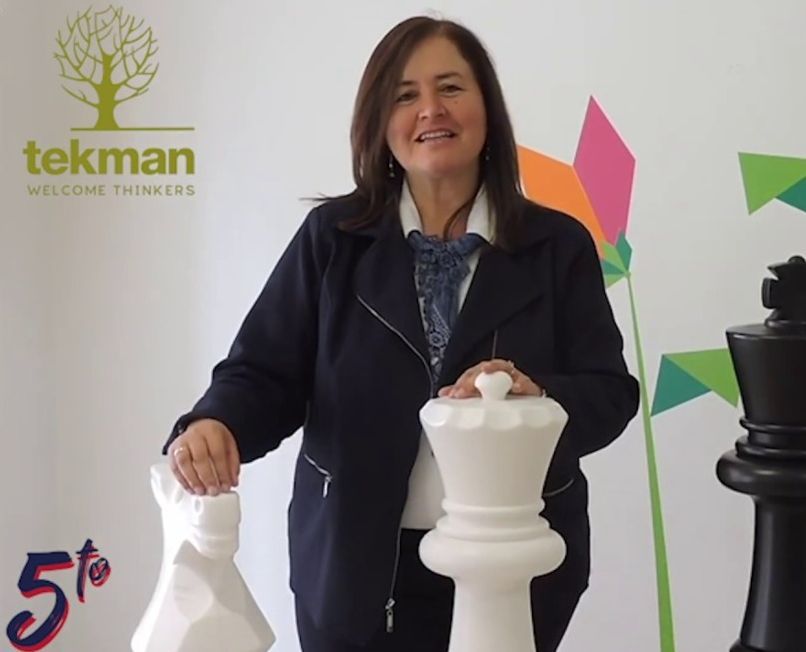
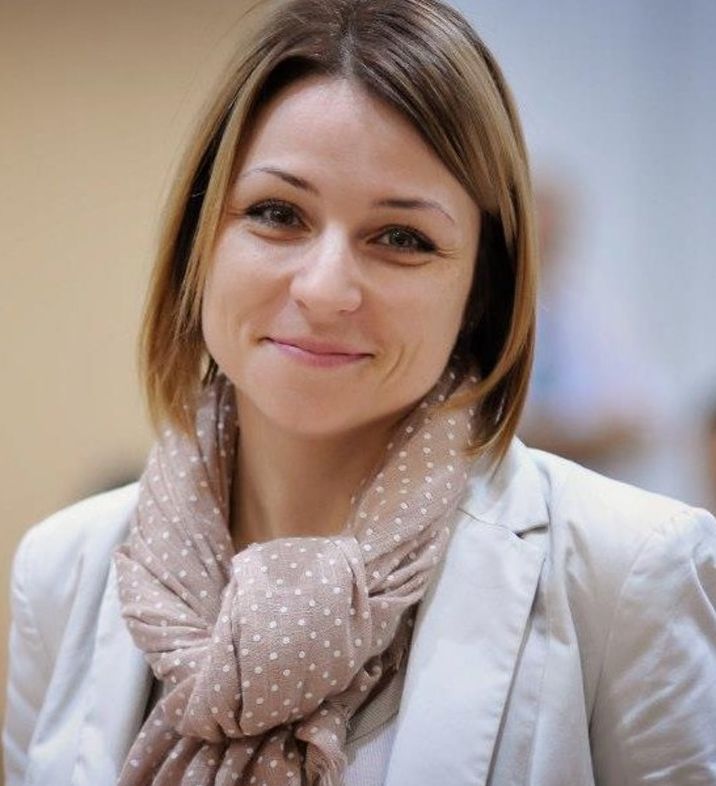


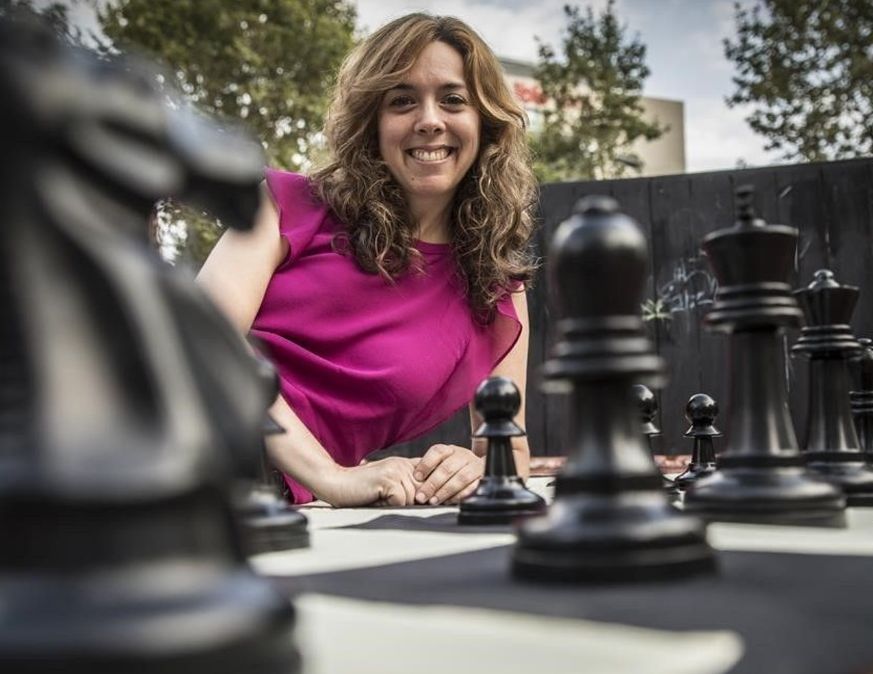


What's More?
Apart from the "Educational Chess Summit," there will be an array of other exciting programs to enjoy if you happen to find yourself at the Hungarian National Gallery, the august venue of the Global Chess Festival, on the 8th of the next month. There's of course the "Chess Challenge Tournament," a free-for-all 5-round swiss tournament that promises to give all its participants an unforgettable experience of playing chess right underneath the Gallery dome. Then there's the festival's signature event, "Catch Me if You Can," a simultaneous exhibition where the host, Judit Polgar herself, and her guest Zsóka Gaál, a 15-year-old Olympian, European age group champion, will play games against multiple opponents at the same time.
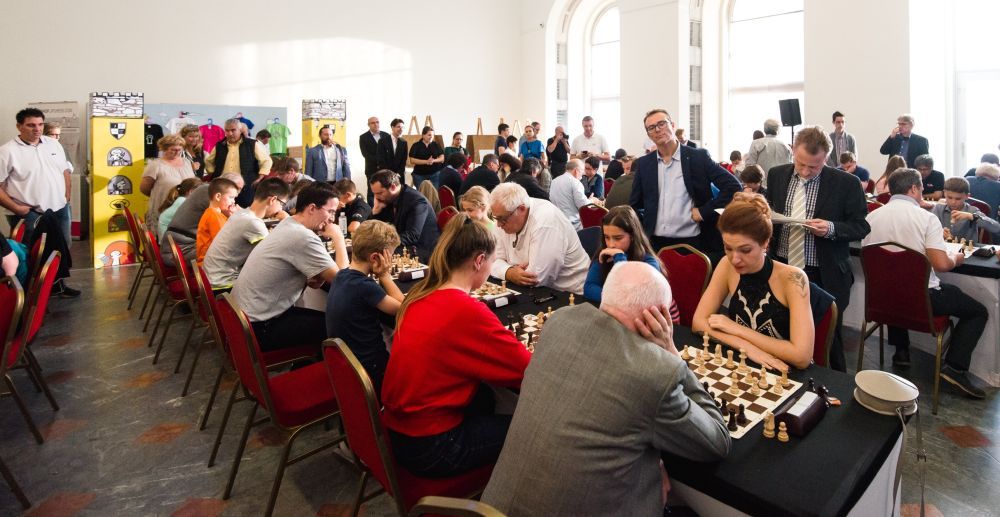
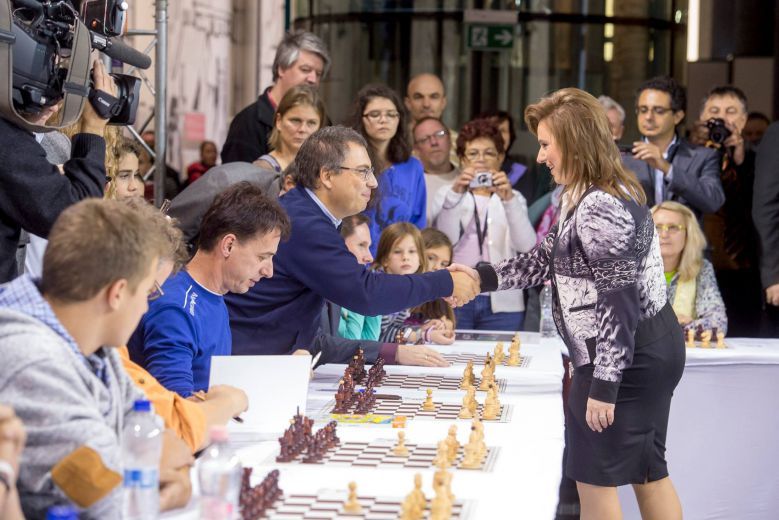

The Morgan Stanley Chess Cafe
Located alongside one of the most famous paintings at the Hungarian National Gallery, Tivadar Csontvary Kosztka’s, ‘Ruins of Greek Theatre at Taormina’, The Morgan Stanley Chess Café will be open from 10:30 to 17:00. This is another fun place to visit if you are at the venue. You could challenge a master, meet the Polgár sisters, play a game of giant chess with family and friends – or simply relax while watching the programs taking place on stage throughout the festival! Besides, there's also an interesting "Test Your Chess" program by GM Krisztián Szabó where you might also pick a chess tip or two.
Don't yet be disappointed if Budapest is too far away from where you live. There's a way you can still join in the fun. Since last year the Global Chess Festival has become a "hybrid event," which means you can enjoy many of the programs online without having to travel thousands of kilometers. For instance, the 2nd Inspiration Cup, a fun hand and brain tournament between four teams of mixed doubles, will be broadcast online. Another hugely important program, "Women in Chess Women in Science," will also be made accessible online. This program will be majorly focused on this year given that 2022 was declared as the Year of the Woman in Chess by FIDE president Arkady Dvorkovich earlier in January. Chess has traditionally been a male-dominated sport and so have the various STEM fields. Discussions and talks in this program will revolve around the socio-biological basis for this performance gap. Myths about gender will be debunked and facts laid out—and you will be able to follow all of that from the comfort of your home!
Chess Artistry Adventure in Memory of Pal Benko
Now let's talk about the one program that we will be covering comprehensively on the ChessBase India YouTube channel and news page. The "Chess Artistry Adventure" is an informal and invitation-only study composing event. Studies, as we know, are composed positions—meaning that they are constructed and are not exactly taken from real games—that show content of intense thematic and artistic value. The composition of studies is an artform in itself, and a study composer is somewhat like a wizard who can make the chess pieces do any fanciful bidding like they were his little elfin minions in total thrall to his charm!
The event has received fourteen high-class studies from some of the best composers in the world. Each study is based on a certain real over-the-board encounter for Judit had this one condition imposed on the composers: their creations had to be inspired by actual games played recently or in the distant past. The result is that we not only have fourteen studies but also fourteen games on which they are based. Intriguing, right? On ChessBase India, we will be covering each of them in detail. These studies will also be posed to various Grandmasters, and you will see how they tackle the difficulties and calculate their way out.
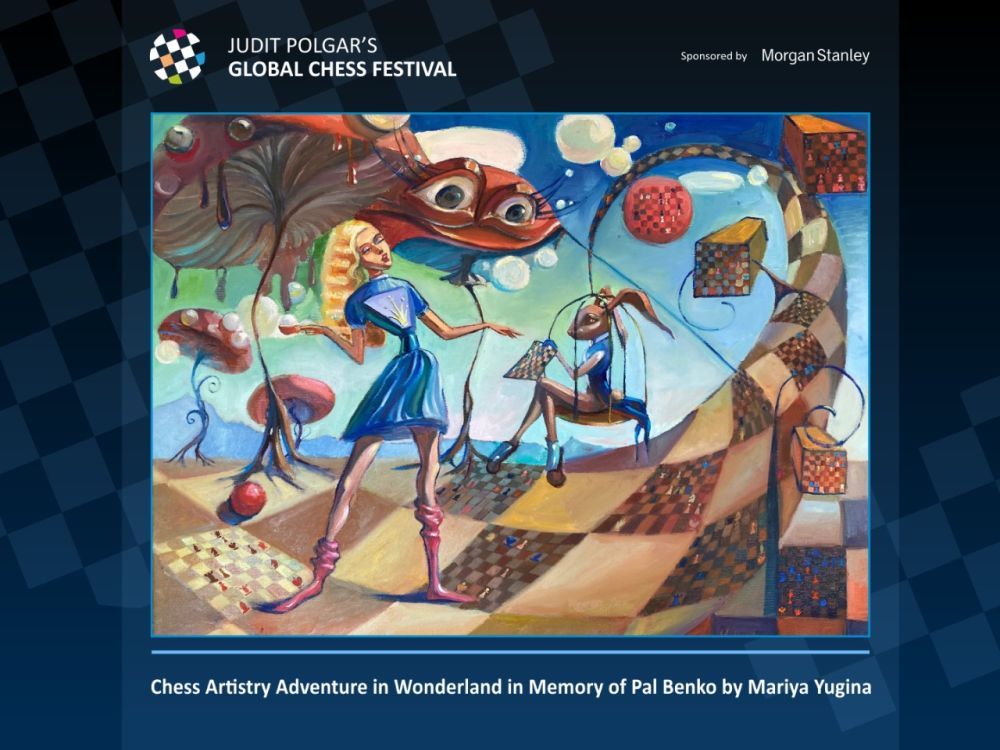
Last but not the least, this event is taking place in memory of Pal Benko who passed away in 2019 at the age of 91. Benko was a versatile chess genius. He played and composed, both at a very high level. Moreover, he was also a coach and had multiple World Chess Champion Candidates as his mentees, Judit herself being one of them. From 1961 to 1975, Benko won the US Championship a record eight times. He also qualified for the Candidates tournament in 1959 and 1962. But in 1970 he turned down a third chance to compete for the World Championship, relinquishing his spot in the Interzonal tournament of that year to Bobby Fischer, who then went on to win the World Championship in 1972—a magnanimous gesture today he is still remembered for.
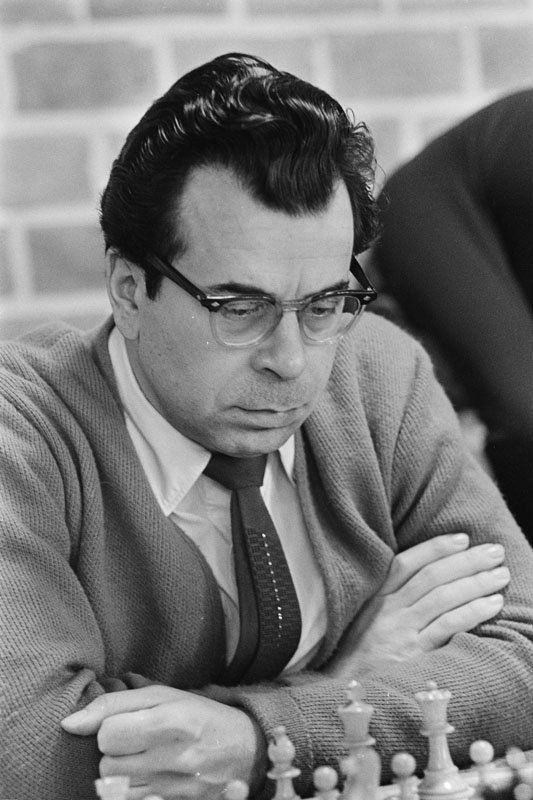

Off the chessboard, too, Pal Benko lived a fighter's life. Born in 1928 in Amiens, France, where his parents were on vacation at the time, and then raised in Hungary, his early childhood was idyllic, but this didn't last long. In his teens, Hungary was wrecked by the Second World War. During this period, he first used to dig ditches for the Hungarian army and later, being captured by the soviets, was forced to become a labourer. Despite all these hardships, Benko became the Hungarian champion at the young age of twenty. Then in 1952, when he was only 24, he tried to defect to America during a tournament in East Berlin but was captured instead and sent to a concentration camp for a year and a half. Be it poverty or starvation or prison-life, Benko braved it all. Perhaps this is the reason why the people who came to know him in the later years remember him as a zestful man, someone appreciative of even the littlest of pleasures in life.
Benko was a great expert of studies and most of the ones he composed were strikingly game-like and at the same time difficult to solve. He liked to challenge his colleagues with problems too. This mate in 4 he created, for instance, is famous for baffling even the fierce Bobby, who failed to crack it within the betted half an hour. What better way is there to honour such a man than by organizing a study composing event?
Study 01 - Purity!!!
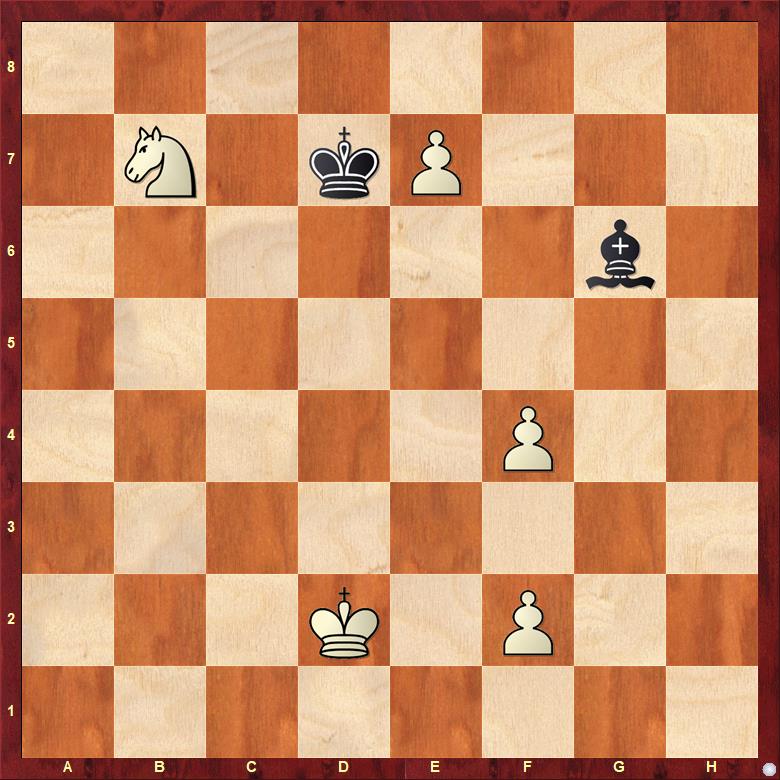
Our first study is by a player-favourite composer. He is known for his brisk and game-like compositions that challenge amateurs and experts alike. The above position with no more than seven units has a rather unassuming look, but you would be surprised when you see all the delicate points that it conceals! This highly efficient interplay between pieces is what Judit Polgar calls "purity."
Solution: 1.f5! This first move begs to be played. As Judit says, "In endgames, sometimes you don't know whether what you're playing is a good move but you don't have any other moves to consider." Now 1...Bxf5 is met with 2.Nd6, and 1...Be8 runs into 2.f6 Ke6 3.f7! Hence, Black continues with 1...Bh5 and now 2.f6 Ke6 - Black thinks he has everything under control, White's pawns don't have any prospects. However, there lurks a deeper tactical idea: 3.e8Q+! Bxe8 4.f7!
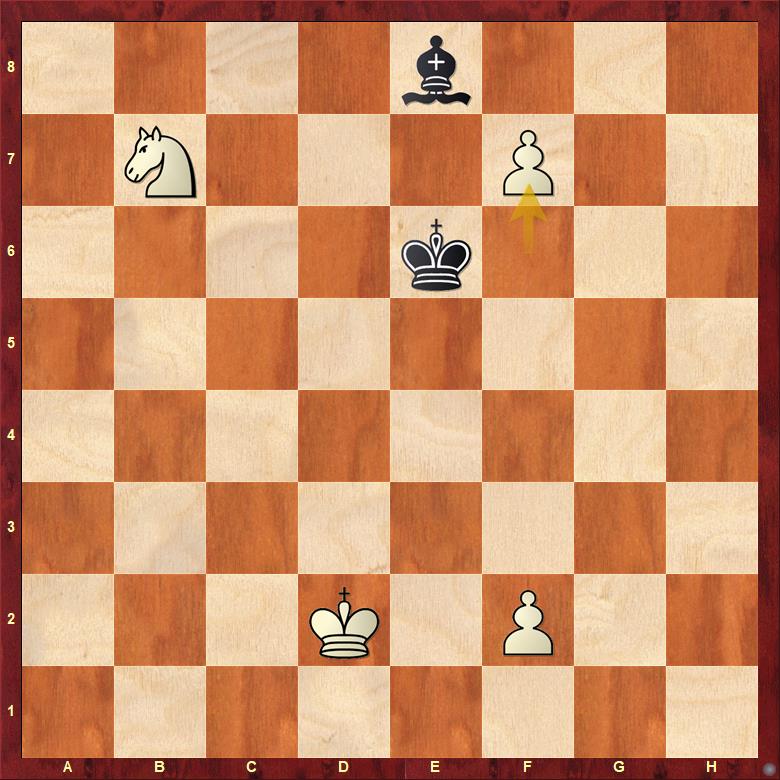
The point is now both Bxf7 and Kxf7 allow a fork and exchange of the minor pieces, following which White achieves a winning a pawn endgame.
4...Kxf7 5.Nd6+ Ke7 6.Nxe8 Kxe8 7.Ke3 wins. The mainline is 4...Bxf7 5.Nd8+ Ke7 6.Nxf7 Kxf7 7.Ke3 Ke6 8.Kf4 Kf6 9.f3 ending in a mutual zugzwang! Note how even the position of the f-pawn matters. Had it been on f3 instead of f2, this would have been only a draw.
This study was based on the following game:
Popov - Grischuk, 2019
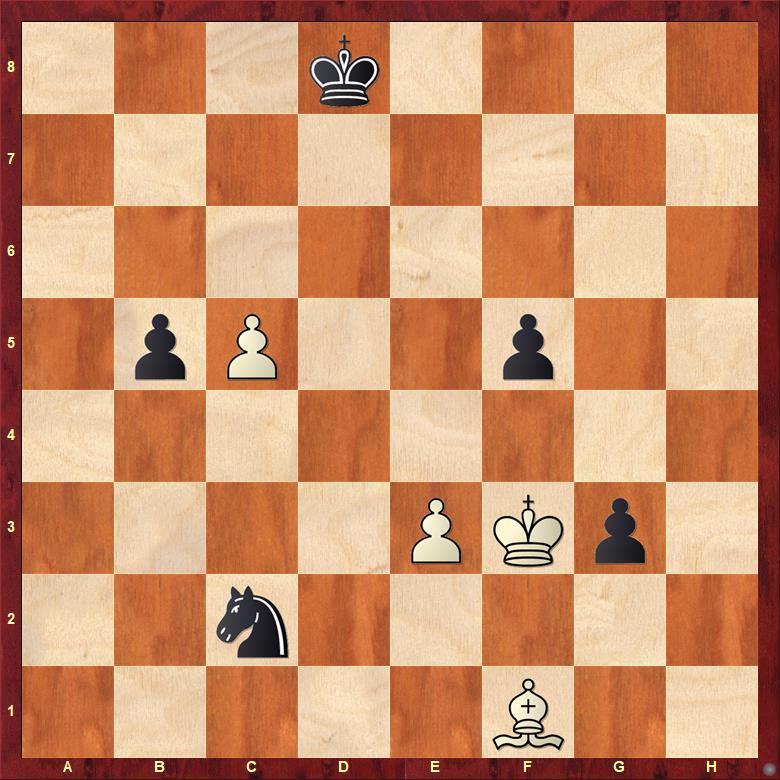
In the position above, Black played 1...g2 and White had to resign as after 2.Kxg2 Ne3+ or 2.Bxg2 Ne1+ Black transposes to a winning pawn endgame!
KNOW YOUR COMPOSER

The composer of the above study is the great Yochanan Afek. A multifaceted chess personality, Afek is a player, composer, trainer and arbiter all rolled into one. He is the author the highly acclaimed book Practical Chess Beauty. Afek has an IM title in OTB chess, and he is a Grandmaster of Chess Composition since 2015.
Study 02 - Sacrifices Galore!!!

The following study is inspired by a fairly recent chess debacle. The author is a renowned study composer from Germany and a master of technique. Unlike the previous one, the crowded board position here is a bit intimidating. But calm down, think of this as a position that has occurred in your own game. You are White, your opponent's king is exposed, how do you proceed?
Solution: 1.Re2! You need to cut off that rook on the e-file and now there are motifs with Qf3+, Nh5+, etc. in the air. 1...Bb6+!? and we are already at the most critical moment. White must decide where he should move his king. 2.Kh2 won't work as we will see further down the line that White needs the second rank to be clear for his c2 rook. 2.Kh1!! - the only move. White need not be worried about 2...Qa8+ as after 2...Kh2, he is completely winning, 3.Qh6# being too much of a threat.
The mainline continues with 2...Rxb3 3.Qf3+!! and now Black can't take on f3 due to Nh5#. White's queen is immune. This also explains why Kf1 on move 2 is wrong. With the king on f1, Rxf3 comes with a check!
3...Kg7 (Black's only option) and 4.Qf6+!! - the queen is offered for the second time in a row, and it still can't be taken due to the looming Nh5#. Black has to go 4...Kg8, and now comes the spectacular finish: 5.Bh7+!! Kxh7 6.Rh2+ Kg8 7.Rh8#
There's even more to this study. If Black plays 2...cxb3 instead of 2...Rxb3, there can be a distinct second line also involving the Qf6+ queen sacrifice. This is given in the detailed annotation below:
Anand - Mamedyarov, Norway Chess, 2022
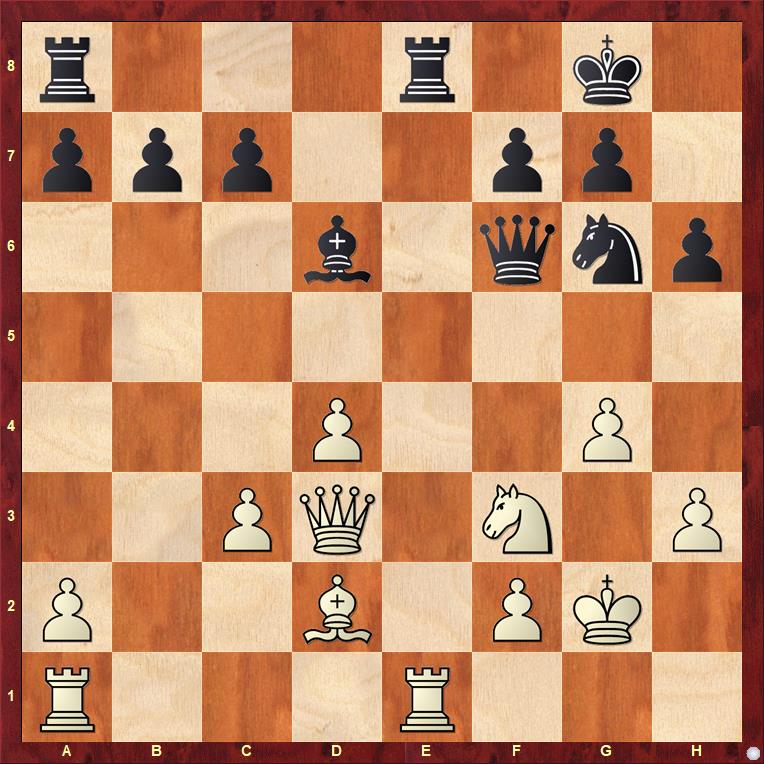
So, the above study was inspired from Anand's game against Mamedyarov that happened not so long ago in Norway. The Indian legend blundered in the above position with 22.Qb5. He immediately resigned after playing this move, even before his opponent could gauge what had happened, and we don't need to tell you why!
KNOW YOUR COMPOSER

Martin Minski is the author of the above study. He is a Grandmaster of Chess Composition and has composed around 600 studies to date. Formerly, he has also been the vice World Champion in study composing. Now, do we even need to mention anymore that, when it comes to study composition, he is among the best in the business?
By his own admission he is a "big fan of Anand" and was impressed by his sportsmanship in this unfortunate game. Here are his observations about how he went about composing this particular study:
"I built this study specifically for this event. So a few months ago I was looking for a motif. There was just this blunder by Anand. He was a fair sportsman and gave up immediately. I'm a big fan of Anand (and have also built another study inspired by a nice winning combination by Anand). I also like queen sacrifices. So I started editing this scheme. I reduced a few pieces and wanted a game-like position with roughly the same material. It was important to me that the queen sacrifice takes place on f6 without capture. Then I came up with the idea of putting the queen on h5 in order to offer it twice for sacrifice. I think it's a modern trend now to combine tactical motives like queen sacrifices with logical motives like 1...Bb6+ 2.Kh1!"
Study 03 - The Battle of Hastings Retold.

The author of this study is not only a distinguished composer but also a legendary chess player; as his wikipedia page states, at his peak, he was regarded to be the best non-Soviet player and was dubbed "The Best of the West." Can you guess who we are talking about? Come back to the study, in the position above, black has an exposed king, but 1.Qg2+ Kb8 2.Rh8+ Kc7 proves too hasty. The king wiggles out and White isn't able to do much. We need a little more restraint!
Solution: 1.a6! First that black king must be put under lock and key. 1...Qc6 prepares to meet the fatal Qh8+ with Re8, but now White sets up a nasty pin, 2.Qg2! Black has to react, 2...Rxe2+, the looming threats of Qxc6+ and Rh8+ leave no other option, and now follows 3.Kd1! Rd2+ 4.Kc1 Rc2+ 5.Kb1! Rxb2+ 6.Kc1! Rc2+ 7.Kd1 Rd2+ 8.Qxd2! The rook can't be taken any earlier. 3.Qxe2 Qxh1+ 2.Kd2 Qd5+ should end in a draw, and so should 4.Qxd2 Qxh1 5.Kc2 Qe4+. On the other hand, 5.Qxc2 Qxh1+ 6.Kd2 Qh2+ even loses for White, going into a pawn ending.

With the b2 pawn gone, the crucial difference after 8.Qxd2 is that the white king now has ample room on the queenside! The next few moves show concretely how this helps: 8...Qxh1+ 9.Kc2 Qe4+ 10.Kb2 The main point! White had to get rid of his b-pawn in order to find a safe passage for his king. 10...Qe7 11.Qh2! The b8 square must be guarded, so the queen swings back to where it started from. And now comes the finish: 11...Qg7 12.Qd6 Qg2+ 13.Ka3 White wins. Black has no way to get at White's king on a3, nor can he defend his back rank! Brilliant!
Steffen Nielsen & Martin Minski, The 100 Years Cup, 2018
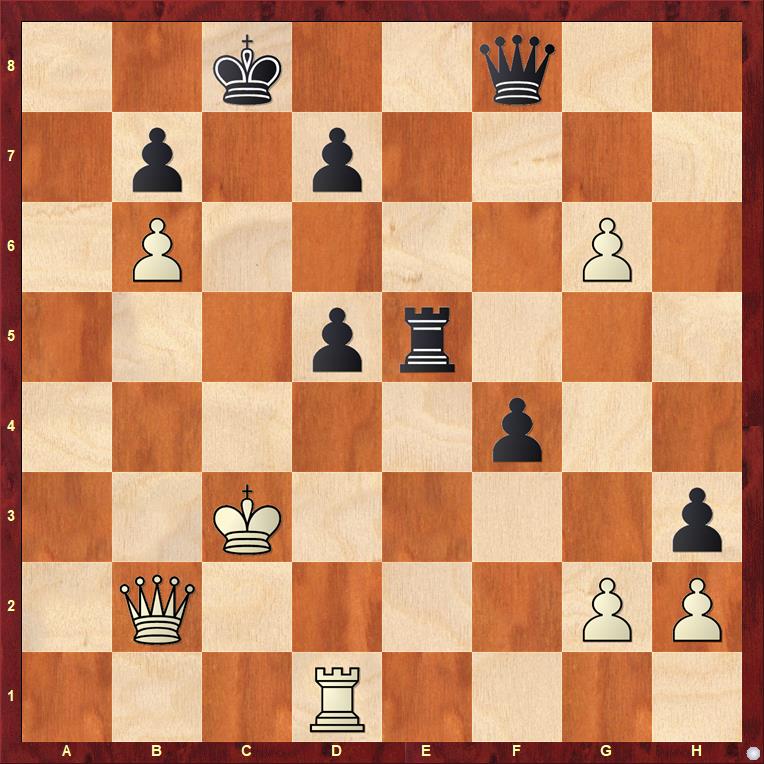
This study is by Nielsen and Minski from 2018. It has the same source of inspiration as the original study 03 that we have just seen, but the main point of both studies are very distinct. The solution here starts with 1.Kd2, which looks like a tough move to find but is actually very logical considering that it opens up the c-file and threatens Black's rook at the same time. And now, after 1...Qf6 2.Ra1, we have the familiar king chase: 2...Re2+ 3. Kd1 Rd2+ 4. Ke1 Re2+ 5. Kf1 Rf2+ 6. Kg1 Rxg2+ 7. Kf1 Rf2+ 8. Ke1 Re2+ 9. Kd1 Rd2+ 10.Qxd2, once again this is the right time to take the rook; 4.Qxd2, for instance, is a logical try but here after 4...Qxa1+ 5.Qc1+ Qxc1+ 6.Kxc1 hxg2, White loses.
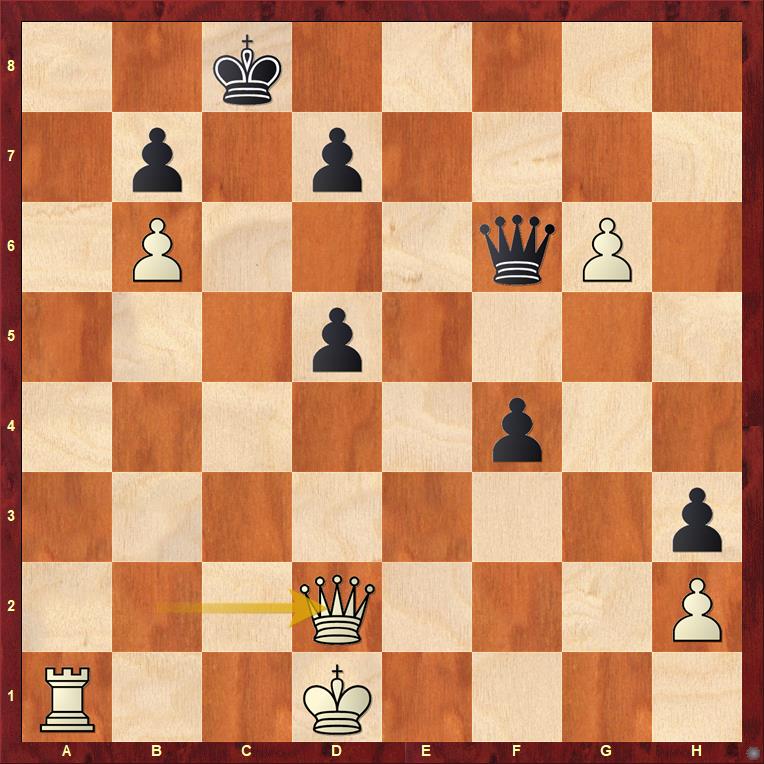
In the above diagram, not only is there no hxg2 but 10...Qxa1+ is now met with 11.Qc1+ (cross-check), forcing a queen trade and liquidating. The final moves: 11...Qxc1+ 12. Kxc1 Kd8 13.g7 and White wins. Black's king is unfortunately a move too slow!
Both the studies above are retelling of the classic Steinitz versus Bardeleben encounter that took place in Hastings in 1895. In this game, Steinitz chased Bardeleben's king in the manner we have just seen, but, unlike in the compositions above, the latter wasn't lucky enough to find a safe shelter for his majesty. About the second study Steffen Nielsen wrote the following on his Facebook page: "I feel a little sorry for those characters in chess history whom we mainly remember for their losses. Levitsky, Kieseritzky, Dufresne, von Bardeleben and many more. This study is a tribute to Curt von Bardeleben by Martin Minski and myself. It is White (Curt von Bardeleben) to play and defeat Steinitz in brilliant fashion!"
The Hastings game with the analysis of the part relevant to this discussion is presented below for you to replay:
KNOW YOUR COMPOSER
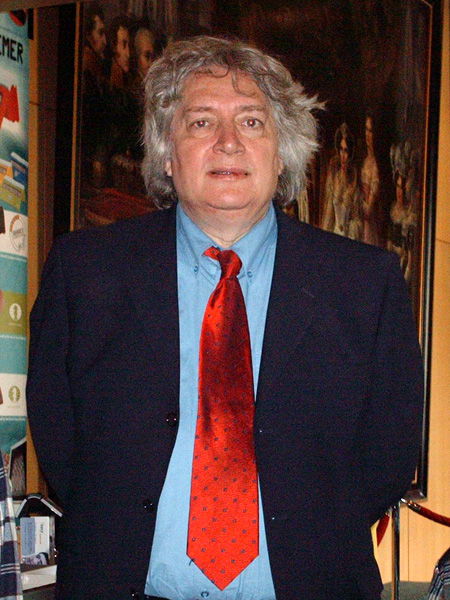
The composer of our third original study, as many of you might have already guessed, is the legendary Dutch Grandmaster Jan Timman. One of the world's leading players during the 80s, Timman won a number of very strong tournaments such as Amsterdam IBM in 1981, Wijk aan Zee in 1981 and 1985, Linares in 1988, the 1989 Euwe Memorial, and the 1989 World Cup tournament in Rotterdam. And in 1982, he was ranked second in the world, only behind then World Champion Anatoly Karpov. But despite having been so active in competitive play, it can be said that Jan Timman is a chess artist at heart. His book "The Art of the Endgame" conveys his strong passion for studies. He regularly participates in composing tourneys and with great success. One just has to look at the recently announced results of the World Championship in Composing for Individuals (WCCI) to know how prolific he is even in this discipline.
Study 04: Giving Magnus Carlsen a Hand!

This looks almost over for White. Is he not falling prey to an inexorable mating attack? Don't be too quick to judge for the composer of this study is well-known for his deception and cunning. He can weave magic out of thin air and will pull a rabbit out of the hat when you least expect it! So let's be patient and see what is the worst that Black can do. 1...Qd1+ 2.Kg2 Qe2+ 3.Kh1 (3.Kg1 Qf2+ and 3.Kh3 Nf2+ lose instantly) 3...Qf3+ 4.Kh2 Qf2+ 5.Kh3 Qf1+ 6.Kh2 Nxf6 and here White has a critical decision to make. His fate will be determined by this next move.
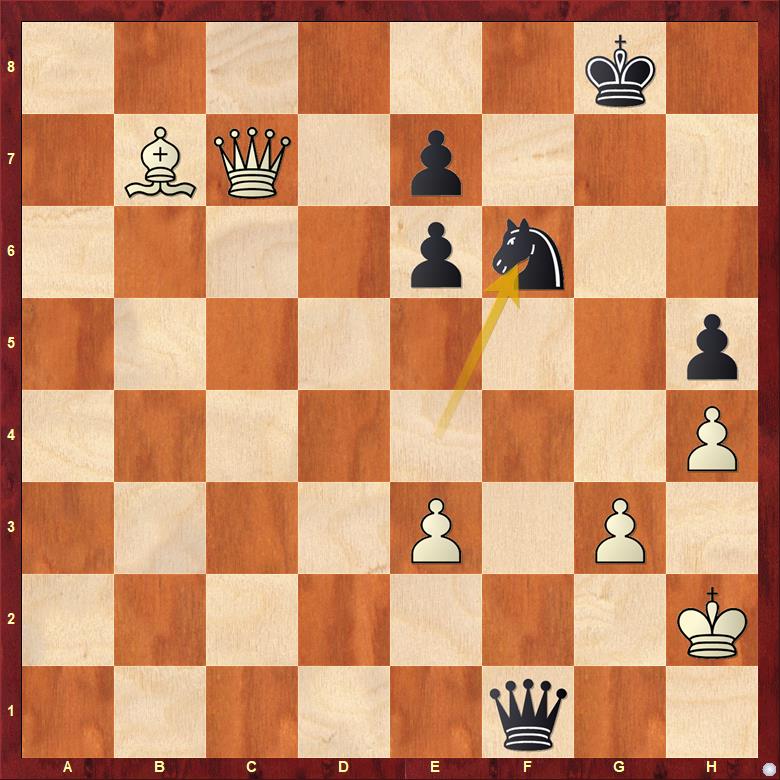
7.Bg2 looks natural but doesn't work because after 7...Ng4+ 8.Kh3 Qg1, the threat of Qh2# is absolutely decisive. 9.Qb8+ Kg7 10.Qb2+ e5 is his best bet, but he still has to give up a queen to prevent mate.7.Qd8+ or 7.Qc8+ doesn't work simply because the black king manages to get out of checks with 7...Kf7, leaving the threat of Ng4 still looming over White. 7.Qb8+!! is the right move, a delicate intermezzo that foresees a nice stalemating plan. Now, 7...Kf7 8.Qf4 and 7...Kg7 8.Qe5 both solve White's problem readily. Hence, Black plays the more testing 7...Kh7. The main-line continues with 8.Bg2 Ng4+ 9.Kh3 Qg1 and here we see the point...
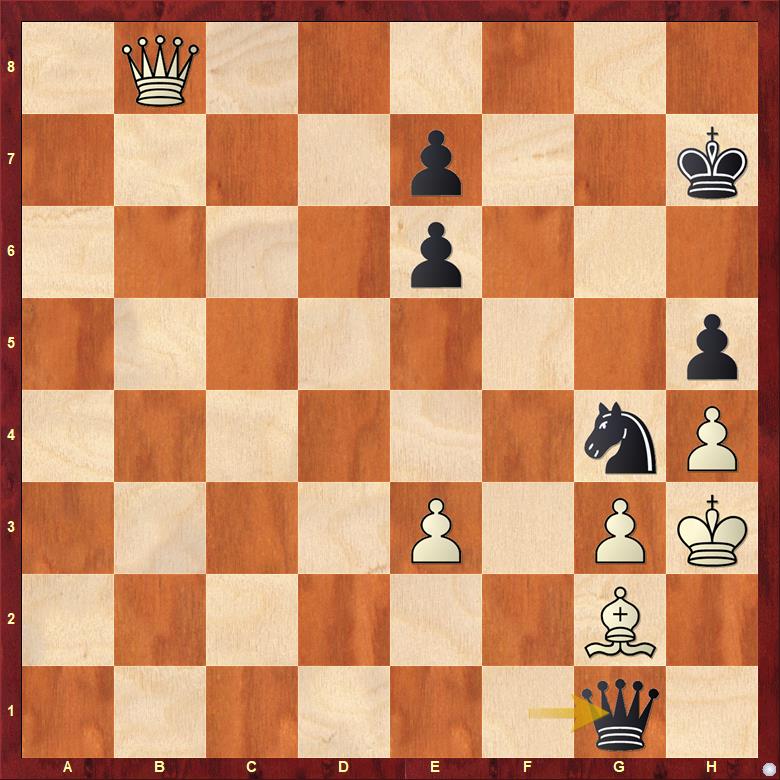
Yes, thanks to the white queen on b-file, now we have 10.Qb1+ Qxb1 11.Be4+ Qxe4 - a most beautiful and unexpected stalemate. Replay the full solution once again below:
Carlsen - Karjakin, World Chess Championship, 2016
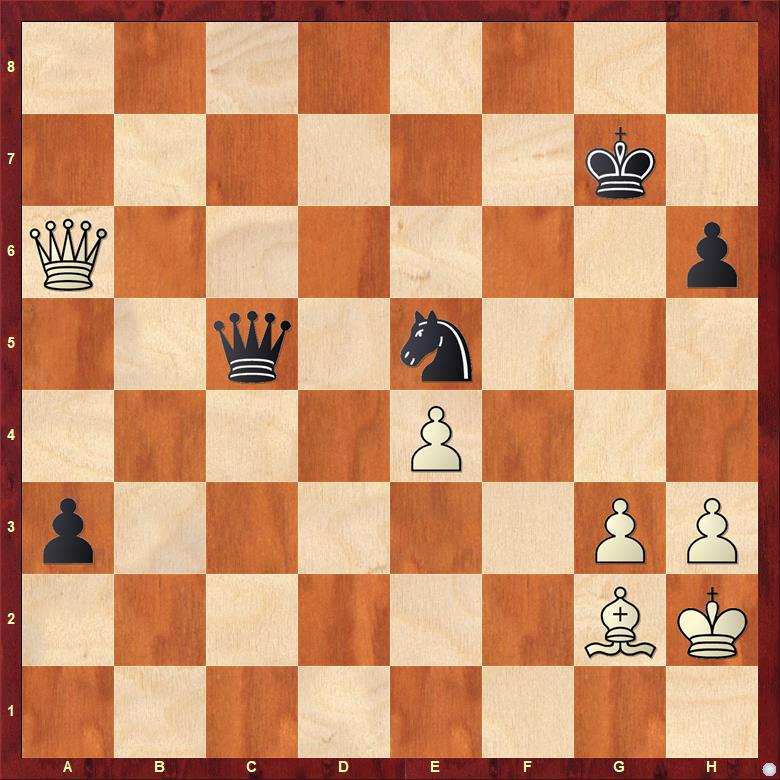
This study was based on the eighth game of Magnus Carlsen versus Sergey Karjakin World Championship Match. In the above position, Magnus had blundered with 51.Qe6 and after 51...h5 52.h4 a2, the World Champion resigned in view of 53.Qxa2 Ng4+ 54.Kh3 Qg1 55.Qb2+ Kg6 - in this position, unfortunately, you can't stop Qh2# unless you give up your queen!
KNOW YOUR COMPOSER

The author of the fourth and the final study in this article is by the great Georgian composer David Gurgenidze. He is another all-round chess personality: player, organizer, author and studies composer. He has created more than 700 studies to date and is a Grandmaster of chess composition since 1990. He was also the World Champion of the WCCI 1998-2000 for studies.
These were four of the 14 studies submitted as originals at the "Chess Artistry Adventure" program of the Global Chess Festival. We will publish the others in the subsequent articles. Instructive videos of strong chess players (Like Praggnanandhaa, Karthikeyan Murali, et al) tackling these studies will also be published on the ChessBase India YouTube channel. These videos will show the audience how one actually goes about thinking and calculating such tough positions.
Important Links
Global Chess Festival main website


















































